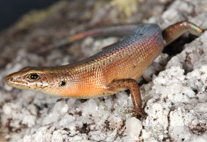Abstract
Carlia skinks are widespread in New Guinea, Wallacea, and northern and eastern Australia. Most Australian species occur in dry woodlands and savannas or marginal rainforest habitats associated with these. There are two rainforest species, parapatrically distributed in coastal mid-eastern Queensland (C. rhomboidalis) and the Wet Tropics of north-eastern Queensland (C. rubrigularis). These two sister species share a diagnostic morphological trait in having the interparietal scale fused to the frontoparietal. Here I describe a third species in this group, Carlia wundalthini sp. nov., from rainforest uplands of the Melville Range, a rainforest isolate 170 km north of the Wet Tropics. This species is diagnosable on male breeding colouration, morphometrics and scalation. The description of C. wundalthini sp. nov. brings the number of vertebrate species known to be endemic to the rainforest and boulder-fields of Cape Melville to seven. Carlia wundalthini sp. nov. is distinct among these endemics in being the only one that does not appear to be directly associated with rock, being found in rainforest leaf-litter.

